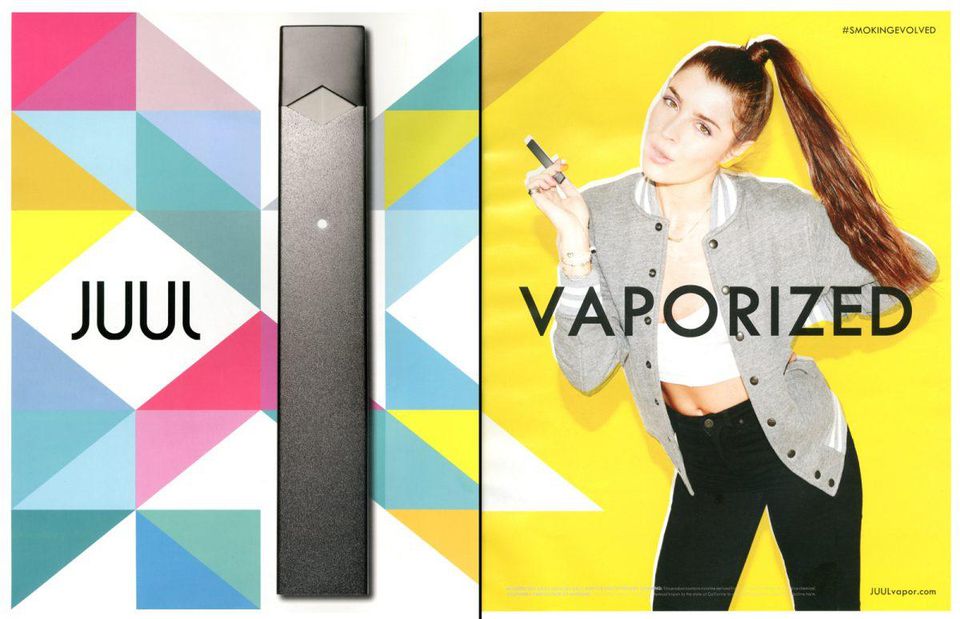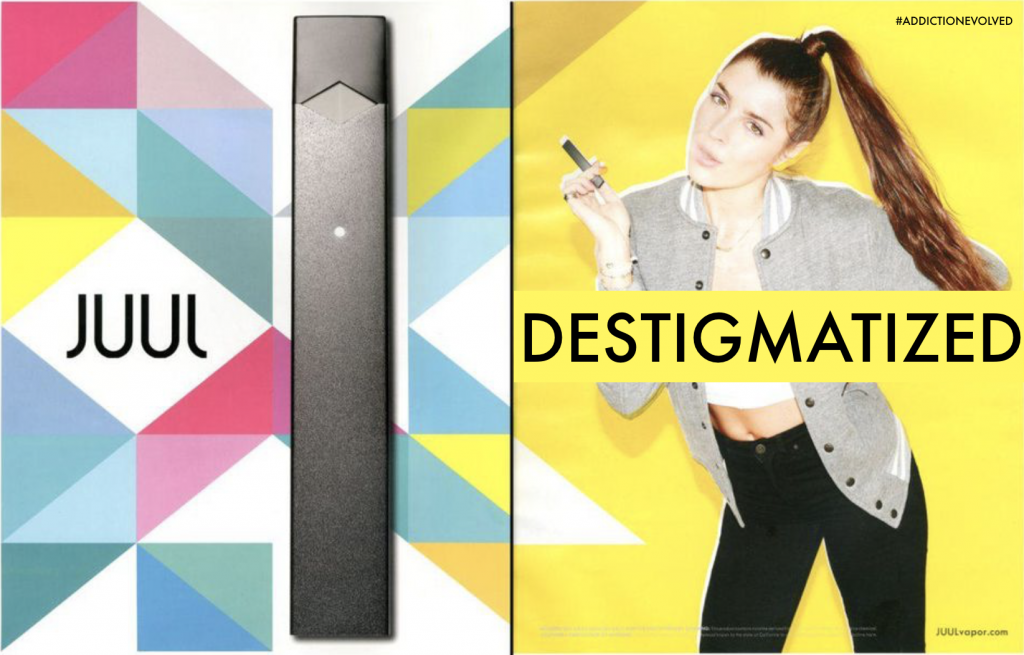The original ad:


On multiple occasions I’ve walked behind or past someone and thought, “Gosh, something smells delicious!” only to discover I’d just walked into a big cloud of their vape breath. Vapes have evolved from bulky, robotic-looking devices to slim, sleek trinkets that can fit in the smallest of pockets. Simultaneously, the customers have evolved from niche, avid vapers to a wider and younger audience than ever imagined.
According to Wells Fargo, in 2018 Juul was valued at $38 billion, and in that very year, Altria bought a 35 percent stake in Juul Labs (Tiku, 2018). Altria is the parent company owning Philip Morris, which owns popular cigarette brands such as Marlboro and Virginia Slims (Capritto, 2019).
Juul’s early marketing campaigns, like the one featured in this blog post, featured colourful graphics and attractive young people using the Juul. These adverts likened the use of Juuls to a thriving social life. “Smoking Evolved” reads the hashtag at the top right of the advertisement. This is a nod to the original aim of Juul as a safer alternative to a cigarette for smokers to transition onto. Juuls eliminate the need to go outside for a cigarette break, they eliminate the use of batteries (they are charged via USB port), and they only produce a small and discreet cloud of vapour upon exhalation. One 5% Juul pod contains the same amount of nicotine as 1 pack of cigarettes (Capritto, 2019). Upon consulting my roommate, an avid Juul user, she admitted to vaporizing a 5% pod a day during her heaviest Juul use periods.
The biggest issue I’d like to address is the clear target audience of this advertisement. Although Juul claimed to be a product for adult smokers, its marketing was catered towards young adults and teens. Through the use of colourful graphics and models that look like high school and college peers, the Juul has been romanticized as a device for socializing, partying, and even flirting. (What in the world does a seductive expression have to do with nicotine?) This has snowballed into the current “youth nicotine epidemic” (Chaykowski, 2018). Young adults and teens start “Juuling” without a previous cigarette addiction, effectively giving themselves a brand new nicotine addiction. Why would anyone knowingly give themselves an addiction? The answer is in the marketing. Juuls are promoted as sleek and cool, giving an “everyone at the party has one, and so should you” mindset.
The jammed ad:


According to Statistics Canada (2012), the largest progress in decline in cigarette smoking was among adolescents. Between 2001 and 2011, females aged 18 to 19 had a decrease in smoking rate from 34.2% to 18.5% and females aged 15 to 17 had a decrease from 22.3% to 8.7% (Statistics Canada, 2012). During that same time period, males aged 18 to 19 had a decrease in smoking from 33.2% to 19.8% and males aged 15 to 17 had a decrease from 19.3% to 10.1% (Statistics Canada, 2012). The stigma around smoking cigarettes has increased drastically. Gone are the days of chain-smoking and greased hair. The thought of cigarettes evokes images of yellowed teeth, rat poison, and cancer nowadays. Although the Juul eliminates other potentially harmful ingredients besides the highly addictive nicotine, Juul also makes nicotine far more accessible. Users can vape indoors without the use of lighters and can simply recharge their Juuls on the sides of their laptops.
In my jammed advertisement, I replaced the heading “Vaporized” with “Destigmatized”. I wanted to propose that Juul has simply placed nicotine in a prettier, cleaner package. This has reduced the stigma around the use of nicotine by giving a modern take on an outdated habit. Destigmatizing a product likely increases its consumption by one of the most easily influenced age groups: adolescents. Young adults and teens are often uncomfortable with judgement from others. Removing the stigma around smoking by providing a fun, clean alternative makes it easy to start vaping without realizing the addictive implications.
I replaced the hashtag “smoking evolved” with the hashtag “addiction evolved”. When you think about addiction, the most dramatic cases often come to mind, such as hard drugs and alcoholism. What about nicotine addictions? People used to be so dependent on the relief from a cigarette drag, that they’d leave school or work several times a day to enjoy one. Now people can enjoy a Juul “hit” every few minutes without even leaving their seat. I’ve claimed that the rise of Juuls has evolved the culture of nicotine addiction because Juuls have made the use of nicotine more efficient and user-friendly. They’ve also changed the context in which we see the use of nicotine. A “dirty” habit is now a sleek metal stick passed around at parties. Who needs cigarette breath when you can Juul flavours like mint, mango, and vanilla bean?
Ultimately, I aimed to make my jammed ad quite streamlined with the original. I think it’s better to have to take a moment to realize that something is a little “off” about the ad. I thought that the subtle “#addictionevolved” hashtag in the corner would raise eyebrows once it was noticed. This issue hits close to home as nearly all of my friends and peers Juul regularly or have tried Juuling in the past. Given the statistics mentioned, it is unlikely that all of them were previously smokers. As the youth nicotine epidemic looms over us, the last thing a nicotine product company should be doing is rolling out enticing advertisement.
References:
Belluz, J. (2019). The vape company Juul said it doesn’t target teens. Its early ads tell a different story. Retrieved from https://www.vox.com/2019/1/25/18194953/vape-juul-e-cigarette-marketing
Capritto, A. (2019). Juul vape: What is it, why are teens addicted, and is it safe? Retrieved from https://www.cnet.com/news/juul-what-is-it-how-does-it-work-and-is-it-safe/
Chaykowski, K. (2018). The Disturbing Focus of Juul’s Early Marketing Campaigns. Retrieved from https://www.forbes.com/sites/kathleenchaykowski/2018/11/16/the-disturbing-focus-of-juuls-early-marketing-campaigns/#1a0846c614f9
Statistics Canada. (2012). Current smoking trends. Retrieved from https://www150.statcan.gc.ca/n1/pub/82-624-x/2012001/article/11676-eng.htm
Tiku, N. (2018). Juul Sheds Its Anti-Smoking Cred and Embraces Big Tobacco. Retrieved from https://www.wired.com/story/juul-sheds-anti-smoking-cred-embraces-big-tobacco/